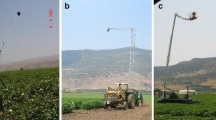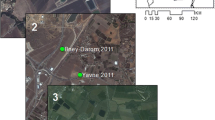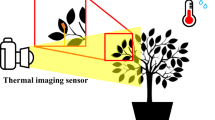Abstract
This paper presents a novel methodology for identifying homogeneous areas within high-frequency drip-irrigated orchards and for defining the most sensitive and resistant areas of the field to water stress. The methodology proposed here is based on the assessment of water status at the tree level during mild water stress using remote sensing derived indicators which provide valuable information about the spatial distribution of the response to water stress within an orchard. The areas more resistant to water stress will maintain a good water status, while those prone to water stress will develop initial symptoms of water deficit. The study was performed over three different peach orchards that were evaluated from 2 to 3 years. Water status was monitored using high-resolution thermal imagery acquired before and after the onset of water stress. The Thermal Sensitivity Index (TSI), derived from the difference of the CWSI and the cumulated reference evapotranspiration between the two dates, demonstrated to be well related to the increase of stem water potential. The spatial distribution of TSI enables the identification of sensitive areas within a peach orchard, a first step for establishing precision drip irrigation programs.










Similar content being viewed by others
References
Agam, N., Cohen, Y., Alchanatis, V., & Ben-Gal, A. (2013). How sensitive is the CWSI to changes in solar radiation? International Journal of Remote Sensing, 34, 6109–6120.
Bazzi, C. L., Schenatto, K., Upadhyaya, S., Rojo, F., Kizer, E., & Ko-Madden, C. (2019). Optimal placement of proximal sensors for precision irrigation in tree crops. Precision Agriculture, 20(4), 663–674.
Bellvert, J., Zarco-Tejada, P. J., Marsal, J., Girona, J., Gonzalez-Dugo, V., & Fereres, E. (2016). Vineyard irrigation scheduling based on airborne thermal imagery and water potential thresholds. Australian Journal of Grape and Wine Research, 22(2), 307–315.
Ben-Gal, A., Agam, N., Alchanatis, V., Cohen, Y., Yermiyahu, U., Zipori, I., et al. (2009). Evaluating water stress in irrigated olives: Correlation of soil water status, tree water status, and thermal imagery. Irrigation Science, 27(5), 367–376.
Berni, J. A. J., Zarco-Tejada, P. J., Gonzalez-Dugo, V., & Fereres, E. (2009). Remote sensing of thermal water stress indicators in peach. Acta Horticulturae, 962, 325–331.
Camp, C. R., & Sadler, E. J. (1998). Site-specific crop management with a center pivot. Journal of Soil and Water Conservation, 53(4), 312–314.
Cohen, Y., Alchanatis, V., Saranga, Y., Rosenberg, O., Sela, E., & Bosak, A. (2017). Mapping water status based on aerial thermal imagery: comparison of methodologies for upscaling from a single leaf to commercial fields. Precision Agriculture, 18(5), 801–822.
Conesa, M. R., Conejero, W., Vera, J., Ramírez-Cuesta, J. M., & Ruiz-Sánchez, M. C. (2019). Terrestrial and Remote Indexes to Assess Moderate Deficit Irrigation in Early-Maturing Nectarine Trees. Agronomy, 9(10), 630.
Dag, A., Cohen, Y., Alchanatis, V., Zipori, I., Sprinstin, M., Cohen, A., et al. (2015). Automated detection of malfunctions in drip-irrigated systems using thermal remote sensing in vineyards and olive orchards. In J. V. Stafford (Ed.), Proceedings of the 10th European Conference on Precision Agriculture (pp 519–525). Wageningen, The Netherlands: Wageningen Academic Publisher.
Dukes, M. D., & Perry, C. (2006). Uniformity testing of variable-rate center pivot irrigation control systems. Precision Agriculture, 7(3), 205–218.
Evans, R. G., Han, S., Schneider, S. M., & Kroeger, M. W. (1996). Precision center pivot irrigation for efficient use of water and nitrogen. In P. C. Robert, R. H. Rust, W. E. Larson (Eds.), Proceedings of the 3rd International Conference on Precision Agriculture. Madison, WI: ASA, CSSA, SSSA.
Fereres, E., Goldhamer, D. A., & Parsons, L. R. (2003). Irrigation water management of horticultural crops. Hortscience, 38(5), 1036–1042.
Fereres, E., & Soriano, M. A. (2007). Deficit irrigation for reducing agricultural water use. Journal of Experimental Botany, 58(2), 147–159.
Gilabert, M. A., Gandía, S., & Melia, J. (1996). Analyses of spectral-biophysical relationships for a corn canopy. Remote Sensing of Environment, 55(1), 11–20.
Girona, J., & Fereres, E. (2012). Peach. In P. Steduto, T. C. Hsiao, E. Fereres & D. Raes (Eds.), Crop yield response to water (pp. 392–406). Rome: FAO.
Gonzalez-Dugo, V., Goldhamer, D., Zarco-Tejada, P. J., & Fereres, E. (2015). Improving the precision of irrigation in a pistachio farm using an unmanned airborne thermal system. Irrigation Science, 33(1), 43–52.
Gonzalez-Dugo, V., Lopez-Lopez, M., Espadafor, M., Orgaz, F., Testi, L., Zarco-Tejada, P. J., Lorite, I. J., & Fereres, E. (2019). Transpiration from canopy temperature: Implications for the assessment of crop yield in almond orchards. European Journal of Agronomy, 105, 78–85.
Gonzalez-Dugo, V., Zarco-Tejada, P. J., & Fereres, E. (2014). Applicability and limitations of using the crop water stress index as an indicator of water deficits in citrus orchards. Agricultural and Forest Meteorology, 198, 94–104.
Hsiao, T. C., Fereres, E., Acevedo, E., & Henderson, D. W. (1976). Water stress and dynamics of growth and yield of crop plants. In Water and plant life (Vol. 19). Ecological studies. Berlin: Springer.
Idso, S. B., Jackson, R. D., Pinter, P. J. J., Reginato, R. J., & Hatfield, J. L. (1981). Normalizing the stress-degree-day parameter for environmental variability. Agricultural Meteorology, 24, 45–55.
Jacob, J., Udayakumar, M., & Prasad, T. G. (1995). Mesophyll conductance was inhibited more than stomatal conductance in nitrogen deficient plants. Plant Physiology and Biochemistry, 17, 55–61.
Johnson, R. S., Handley, D. F., & DeJong, T. M. (1992). Long-term response of early maturing peach trees to postharvest water deficits. Journal of the American Society for Horticultural Science, 117, 881–886.
Jones, H. G., Stoll, M., Santos, T., Sousa, C. D., Chaves, M. M., & Grant, O. M. (2002). Use of infrared thermography for monitoring stomatal closure in the field: Application to grapevine. Journal of Experimental Botany, 53(378), 2249–2260.
McClymont, L., Goodwin, I., Mazza, M., Baker, N., Lanyon, D. M., Zerihun, A., et al. (2012). Effect of site-specific irrigation management on grapevine yield and fruit quality attributes. Irrigation Science, 30, 461–470.
O’Shaughnessy, S. A., Evett, S. R., & Colaizzi, P. D. (2015). Dynamic prescription maps for site-specific variable rate irrigation of cotton. Agricultural Water Management, 159, 123–138.
Radin, J. W., & Parker, L. L. (1979). Water relations of cotton plants under nitrogen deficiency. II. Environmental interactions on stomata. Plant Physiology, 64, 499–501.
Ramírez-Cuesta, J. M., Kilic, A., Allen, R., Santos, C., & Lorite, I. J. (2017). Evaluating the impact of adjusting surface temperature derived from landsat 7 ETM+ in crop evapotranspiration assessment using high-resolution airborne data. International Journal of Remote Sensing, 38(14), 4177–4205.
Sadler, E. J., Camp, C. R., Evans, D. E., & Usrey, L. J. (1996). A site-specific center pivot irrigation system for highly variable coastal plain soils. In P. C. Robert, R. H. Rust, W. E. Larson (Eds.), Proceedings of the 3rd International Conference on Precision Agriculture. Madison, WI: ASA, CSSA, SSSA.
Sadler, E. J., Evans, R. G., Stone, K. C., & Camp, C. R. (2005). Opportunities for conservation with precision irrigation. Journal of Soil and Water Conservation, 60(6), 371–379.
Schepers, A. R., Shanahan, J. F., Liebig, M. A., Schepers, J. S., Johnson, S. H., & Luchiari, A. Jr. (2004). Appropriateness of Management Zones for Characterizing Spatial Variability of Soil Properties and Irrigated Corn Yields across Years. Agronomy Journal, 96(1), 195–203.
Smith, R. J., Baillie, J. N., McCarthy, A. C., Raine, S. R., & Baillie, C. P. (2010). Review of precision irrigation technologies and their application. Project Report. Toowoomba: University of Southern Queensland, National Centre for Engineering in Agriculture.
Testi, L., Goldhamer, D. A., Iniesta, F., & Salinas, M. (2008). Crop water stress index is a sensitive water stress indicator in pistachio trees. Irrigation Science, 26, 395–405.
Yan, L., Zhou, S., Cifang, W., Hongyi, L., & Feng, L. (2007). Classification of management zones for precision farming in saline soil based on multi-data sources to characterize spatial variability of soil properties. Transactions of the Chinese Society of Agricultural Engineering, 23(8), 84–89.
Zarco-Tejada, P. J., Gonzalez-Dugo, V., & Berni, J. A. J. (2012). Fluorescence, temperature and narrow-band indices acquired from a UAV platform for water stress detection using a micro-hyperspectral imager and a thermal camera. Remote Sensing of Environment, 117, 322–337.
Acknowledgements
Authors acknowledge Rafa Romero, Alberto Vera and David Notario for their technical support with imagery acquisition and processing; and José S. Rubio-Asensio, Margarita Parra, Ignacio Buesa, Alejandro Martínez, Antonio Yeves, Felipe Sanz, David Hortelano and Diego Guerra for their help with field measurements.
Funding
This research was funded in the frame of the collaborative international consortium IRIDA financed under the ERA-NET Cofund Water-Works 2014 Call with Spanish national funds from the Agencia Estatal de Investigación grant PCIN-2015-263. This ERA-NET is an integral part of the 2015 Joint Activities developed by the Water Challenges for a Changing World Joint Programme Initiative (Water JPI) JPIWaterWaterWorks 2014. Funding from the Spanish Ministry of Science and Innovation (AGL2017-90666‐REDC and RTI2018-096754-J-I00) is also acknowledged. V.G.-D. was supported by a postdoctoral scholarship from the ‘Ramon y Cajal’ programme Spanish Ministry of Economy and Competitiveness (RYC2018-024994-I).
Author information
Authors and Affiliations
Corresponding author
Additional information
Publisher’s Note
Springer Nature remains neutral with regard to jurisdictional claims in published maps and institutional affiliations.
Rights and permissions
About this article
Cite this article
Gonzalez-Dugo, V., Zarco-Tejada, P.J., Intrigliolo, D.S. et al. Normalization of the crop water stress index to assess the within-field spatial variability of water stress sensitivity. Precision Agric 22, 964–983 (2021). https://doi.org/10.1007/s11119-020-09768-6
Accepted:
Published:
Issue Date:
DOI: https://doi.org/10.1007/s11119-020-09768-6




